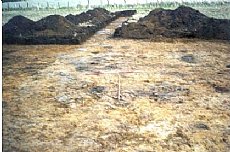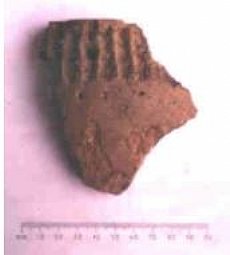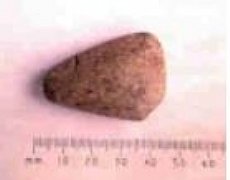Kinbeachie Neolithic settlement
08 August 2020
- News Type:
- Site of the Month

© Jonathan Wordsworth
Kinbeachie on the north side of the Black Isle provides a good example of a site located by repeated fieldwalking. First by the farmer, then by a local field club, it produced flint and pottery, and the farmer paid for his own C-14 dates. This then led to Historic Scotland doing geophysical survey followed by trial trenching. All finds except for one beaker sherd, and C-14 dates show that the site was used in the Neolithic between 3500 and 2920 BC., providing a good snapshot of Neolithic occupation. The excavators felt that the occupation may have been as short as one generation in this period. It is located in an area with a number of chambered cairns, but this is the first indication of settlement.

© Jonathan Wordsworth
The site is important because it was one of the first indications of Neolithic structures on the Highland mainland, showing a number of post holes in a roughly rectangular pattern. This in turn led to similar sites being identified in the Highlands, particularly around Inverness, and further help in interpreting the structure underneath the Raigmore Bronze Age cairn (MHG45837). The nature of the structure – whether domestic or ritual – remains unclear, although there may of course be overlap in functions.
The site had a number of pits which produced Impressed ware pottery (at least 8 vessels), also found in the rectangular structure. Some had clearly been used for cooking. The C-14 dating provides important evidence for the dating of its use in the Highlands. The presence of a number of pits with Neolithic remains is similar to a number of sites subsequently excavated in the Inverness area.

© Jonathan Wordsworth
There were also a number of lithics, many of flint, and other worked stone found in the fieldwalking and excavation. These included a leaf-shaped arrowhead, a small, polished stone axehead, probably made from local stone, flint scrapers and other flakes and retouched pieces. These were probably not made on site because of the relatively small amount of debitage and the fact use-wear analysis showed that almost all were used. The axehead was unused, and may be ritual given its small size and polished surface.
The environmental evidence from the excavation showed naked barley and some emmer wheat, again linking the site to common Neolithic evidence. Seeds of agricultural weeds and plants from non-agricultural habitats were almost entirely lacking, but there were hazel nuts and a stone from a Prunus species. Acid soils would have destroyed bone evidence, and only a small amount of burnt bone was found.
The excavators concluded that ‘The simplest interpretation is perhaps that the site was a small farming settlement comprising one or more small rectangular timber buildings. Crops of barley and wheat were cultivated and wild foods such as hazel nuts and cherries were gathered…These settlements are not readily detected by standard archaeological prospection techniques (field-walking, geophysical survey and aerial reconnaissance… The results from Kinbeachie suggest that if these elusive Neolithic settlement sites are to be identified, much greater attention needs to be paid to isolated records of specifically Neolithic finds, especially pottery, as well as the major lithic scatters which can too easily dominate the results of field-walking projects. It is also important to note that if a site is regularly yielding pottery after ploughing it must be experiencing increasing plough truncation. The long-term preservation of shallow near-surface archaeological features is unlikely to be possible and the only course of action that can be recommended is prompt excavation’ (Barlay et al 2001, 76).
The finds are in Inverness Museum and Art Gallery.
Further information
Wordsworth, Jonathan 2003. ‘KINBEACHIE FARM, BLACK ISLE. An ARABLE FARM with BURIED ARCHAEOLOGY. CSA Rural Archaeology Case Study 1’ (available from the ARCH website in the Sites folder)
Highland HER MHG58909 https://her.highland.gov.uk/Monument/MHG58909
Site of the Month Archive
- 10/04/2021 Easter Raitts township
- 02/03/2021 Lower Slackbuie, Inverness (ASDA) Neolithic site
- 01/02/2021 Balnuaran of Clava cairns
- 04/01/2021 Wilkhouse Inn
- 02/12/2020 Spinningdale Cotton Mill
- 02/11/2020 Skibo A Canadian Forestry Camp
- 01/10/2020 WWI Detonator Store, Dalmore near Invergordon
- 03/09/2020 Mesolithic Shell Midden at Sand, Wester Ross
- 08/08/2020 Kinbeachie Neolithic settlement
- 01/07/2020 Armadale Cist Burial and Stone & Timber Complex
